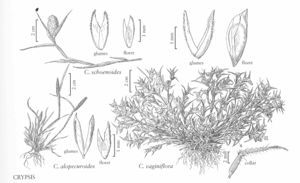Difference between revisions of "Crypsis vaginiflora"
imported>Volume Importer |
imported>Volume Importer |
||
| Line 47: | Line 47: | ||
|publication year= | |publication year= | ||
|special status=Introduced | |special status=Introduced | ||
| − | |source xml=https:// | + | |source xml=https://bitbucket.org/aafc-mbb/fna-data-curation/src/2e0870ddd59836b60bcf96646a41e87ea5a5943a/coarse_grained_fna_xml/V25/V25_699.xml |
|subfamily=Poaceae subfam. Chloridoideae | |subfamily=Poaceae subfam. Chloridoideae | ||
|tribe=Poaceae tribe Cynodonteae | |tribe=Poaceae tribe Cynodonteae | ||
Revision as of 21:04, 5 November 2020
Culms 1-30 cm, often profusely branching above the base, with 10-25 panicles per culm. Sheaths pilose on the margins; collars pilose; blades 1-5 cm long, 1-3 mm wide, soon disarticulating, thus many leaves on mature plants are bladeless. Panicles 0.3-1.5(3.5) cm long, 3-6(10) mm wide, 1-5 times longer than wide, sessile or almost so, mostly included in the sheaths of the upper 2 leaves. Spikelets 2.5-3.2 mm, readily disarticulating when disturbed, otherwise retained within the upper sheaths. Glumes about 3 mm, subequal; lower glumes pilose on the margins; lemmas subequal to the glumes; paleas minutely 2-veined; anthers 3, 0.5-0.9 mm. Caryopses 1.3-1.7 mm. 2n = 48.
Discussion
Crypsis vaginiflora is common to abundant in clay or sandy clay soil in California, where it was first introduced in the late 1800s. It has since been found at a few locations in Washington, Idaho, and Nevada, and will probably spread to additional sites with suitable habitat in the future. It is native to Egypt and southwestern Asia.
Selected References
None.
